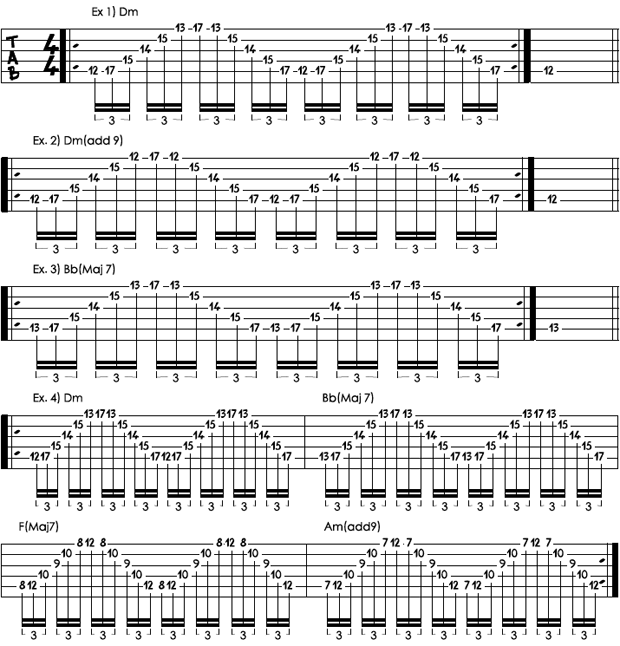Extending Common Sweep Patterns
Learn how to create several different arpeggios by slightly altering one of the most common sweep picking patterns.

In this lesson, I’ll be taking one of the most common sweep picking patterns (EXAMPLE 1) and showing you how to slightly alter it, creating several different arpeggios.
It’s a cool way to take something ordinary and give it a more unique sound and vibe.
First, let's take a look at EXAMPLE 1. This is a D minor arpeggio (D, F, A) that starts and ends on the fifth of the chord (A). It’s one of the first sweep patterns rock and metal guitarists learn because of its applicability, and it's relatively easy for your left hand.
Notice there are two notes on the lowest string of the sweep (fifth string, A) and two notes on the highest string of the sweep (first string, E). Whenever you are sweeping and need to change direction, you can always put two notes on a string. This simplifies the picking for your right hand and makes it easier to change direction on the fly. The remainder of this lesson is based around this arpeggio, so make sure to have this down before you move on to the next examples.
For EXAMPLE 2, I’ll be playing the same sweep as EXAMPLE 1, but instead of playing the 3rd of the chord, F, on the highest string (first string, 13th fret), I’m going to play E (first string, 12th fret). This makes EXAMPLE 2 a Dm(add 9) arpeggio (D, F, A, E). This sweep has a completely different sound than a Dm arpeggio, yet it is almost identical in fingering.
Now, let's move on to EXAMPLE 3. This arpeggio is identical to EXAMPLE 1 with the exception of one note. Instead of playing the 5th of the chord, A, on the lowest string of the sweep, (fifth string, 12th fret), I’m going to play a Bb (fifth string, 13th fret). This changes the arpeggio from Dm to Bbmaj7. Sonically, this is even farther removed from our original example, yet it is nearly the same shape and the same picking pattern for your right hand.
For EXAMPLE 4, I’m going to use previous examples and string them together into a four-chord progression. The progression is Dm, Bbmaj7, Fmaj7, Am(add9). The Dm and Bbmaj7 chords are the same fingerings as EXAMPLE 1 and EXAMPLE 3, respectively. The Fmaj7 arpeggio is the same pattern as EXAMPLE 3, just shifted down the neck; now the root note of the arpeggio is F (fifth string, eighth fret). Similarly, the Am(add9) arpeggio is the same pattern as EXAMPLE 2, just moved down the neck.
What I like about this lesson is that even though the final example sounds complex, the picking pattern for every chord is identical, which makes it easy to execute. Once you work the speed up of one example, you should, in theory be able to play the other examples at the same speed. I’d encourage you to take these patterns and create progressions and licks of your own all over the neck. There are endless possibilities. Cheers!

Sammy Boller is the guitarist for the Detroit rock band Citizen Zero. They’re touring and recording their first full-length album with Al Sutton and Marlon Young (Kid Rock, Bob Seger, Uncle Kracker). In 2012, Boller was selected by Joe Satriani as a winner of Guitar Center’s Master Satriani competition. He studied music at the University of Michigan. For more about Boller, or to ask him a question, write to him at info@sammyboller.com or follow him on Twitter.
Get The Pick Newsletter
All the latest guitar news, interviews, lessons, reviews, deals and more, direct to your inbox!
“There are so many sounds to be discovered when you get away from using a pick”: Jared James Nichols shows you how to add “snap, crackle and pop” to your playing with banjo rolls and string snaps
Don't let chord inversions bamboozle you. It's simply the case of shuffling the notes around







![Joe Bonamassa [left] wears a deep blue suit and polka-dotted shirt and plays his green refin Strat; the late Irish blues legend Rory Gallagher [right] screams and inflicts some punishment on his heavily worn number one Stratocaster.](https://cdn.mos.cms.futurecdn.net/cw28h7UBcTVfTLs7p7eiLe.jpg)


